UNL Barkley Speech Language and Hearing Clinic
At-Home Speech-Language Activities and Resources
Help Improve This Site!
Complete a short survey so we can continue to provide the helpful resources you need.
Resources
Language Delay/Disorder
For students with limitations in their vocabulary, pronoun usage, alphabet awareness, reading development, or narrative understanding.
| Vocabulary Development | |
What: This website provides step-by-step instructions for using context clues to help develop vocabulary. Context clues support vocabulary development in that they not only teach children how to use vocabulary functionally, but they also teach them how to infer a word’s definition when they are unfamiliar with it. Who: This requires parent support. | |
What: This website allows students to choose their own vocabulary in order to make learning new words both more engaging and fun through a variety of academic activities that are available to download. Who: This requires parent support. | |
What: This resource provides step-by-step instructions on how to turn teaching vocabulary words into a game for younger students who may benefit from more engaging activities. Who: These are easy to adjust to any age or grade level, but require parent support. | |
What: The resource, Vocabulary Mini Games, provides step-by-step instructions for implementing mini games at home to support your child's vocabulary development. Who: These could be easily adjusted to serve any age or grade level, but require parent support. | |
| Literacy Development | |
What: This website offers specific instructions for an alphabet matching game that can promote alphabet awareness and supports reading development. This can be accomplished by having your child match the beans by letter or sound, list words that start with a particular letter, spell out new vocabulary or spell sight words from their school curriculum using the beans. Who: This could easily be adjusted to serve any age or grade level, but requires parent support. | |
 | What: This PDF provides your child with a step-by-step outline to identify story grammar elements. This supports reading development, reading comprehension and sentence development as the child reads/listens to the story. While following along or after the story is finished, you and your child can discuss the events while filling out the corresponding "story map" (e.g. setting=where/when, character=who, etc.). Who: This can be modified for any school-age student and will be promoted by parent support and discussion. |
 | What: This worksheet provides the student with another way to expand their vocabulary by repeated vocabulary practice and using it in a variety of ways to promote understanding. This could be accomplished while reading a book and asking the child to pick out a word that is new/less familiar to them and then discussing it together while filling out the worksheet. You can also check for your child’s understanding by having them define it or create sentences using it throughout the day. Who: This can be modified for any school-age student and will be promoted by parent support and discussion. |
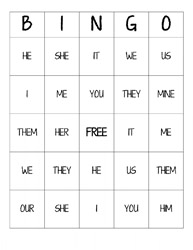 | What: The attached worksheet can be printed out to promote pronoun usage through a game of bingo. You and your child can read a book together, while you ask question prompts about the pictures. Such prompts may be, "Who is petting the cat? (i.e. he, she, etc.)". Depending on their response, it will also provide you with ways to support their helping verb use in sentence (i.e. she is, they are). The bingo sheets can also be modified for use in a variety of activities to support their language – be creative and make learning fun! Who: Parent instruction will be required for this activity. |
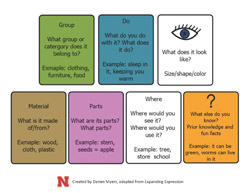 | What: Using the visual, have your child use cards from a game such as Heads Up or parent selected images from the Internet. Then, you can each take turns drawing a card and describing it for one another to guess. This promotes sentence length and vocabulary use. It could be more enjoyable to incorporate siblings or friends to make this more engaging and fun for the student(s). This visual explicitly walks you and your student through eight ways to increase their sentence length/responses when describing the objects. Example: Target word – Apple: "It is red." vs. "This may look red or green and has seeds in it. It is a round shape. You can find this fruit growing on trees. In the fall, you can use it to make pies." Who: This can be modified for any school-age student. It will require parent support. Contributed by: Darien Myers |
 | What: The resource above was designed through the “Read It Once Again” program. The activity, “One Duck Stuck Creative Writing Stories”, specifically works on stimulating a student’s creative writing, spelling, reading and phonemic awareness skills. This YouTube video that features a read aloud of the story that corresponds with the activity. Using a combination of motivating activities with the book, the child is encouraged to expand his or her learning through drawing, writing, and prediction and comprehension questions. Who: Caregiver support, education and familiarity with the activity will be key. See the activity for suggestions on implementing multiple skills. |
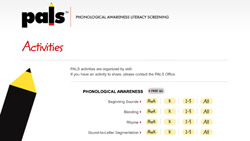 | Phonological Awareness Literacy Screening What: The link above directs individuals to the Phonological Awareness Literacy Screening website. Once there, you will be able to print multiple activities related to sound awareness, rhyming, alphabet recognition, comprehension, writing, spelling, etc. Each skill has the ability to be downloaded for a specific grade level (i.e. preschool, kindergarten and 1st-3rd grade). The downloadable resource walks you through the steps to follow, as well as what materials are required. Who: Caregiver instruction and support required. |
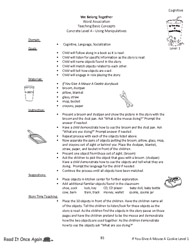 | What: The resource below is also by the “Read It Once Again” program. This activity, “We Belong Together”, helps students practice naming and matching objects (e.g., broom and dust pan) while reading along with the book If You Give A Mouse A Cookie. Throughout the activity, you can also work on following directions and understanding location terms such as when gluing objects beside, under, on, above, etc. This link takes you to an online reading of If You Give A Mouse A Cookie in case you do not have the book available at home. Who: Caregiver instruction and support required. |
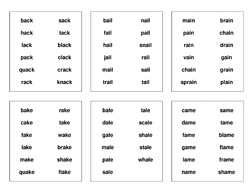 | What: This PDF features word family cards that can be used to capitalize on a variety of individualized skills related to phonics, spelling, rhyming, decoding, etc. Creative activities could include rolling a dice to determine which word to decode (i.e. 5 down) or which word to spell. Parents can make it into a game where the child can earn a set amount of points toward a reward. Who: Caregiver instruction and support required. |
 | Compare and Contrast Worksheet What: A student’s reading and language skills can be increased by implementing a compare and contrast worksheet. Through using this, students can demonstrate understanding around the concept by identifying similarities and differences while reading. Examples may include comparing sports, seasons, TV characters, etc. Who: Caregiver instruction and support will be required. |
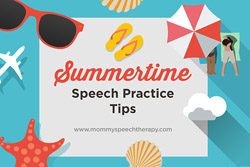 | What: This link directs you to Heidi Hank’s blog, a speech language pathologist, featuring speech therapy activities for home practice. The activities are all featured incorporating summertime themes. Each activity can be modified to your child/student’s goals (e.g., rhyming, spelling, sentence formulation, verb tenses, etc). Who: Parent execution and support required. |
 | What: The link above directs you to the Educational Insights website. Their team has compiled a list of at home activities by grade level for children (i.e., Pre-k to 6th grade). You also can select home schedule ideas for ages 12 months up to 8 years old. Printable activities for each level are related to brain benders, art, preschool, reading & spelling, math, and science. Additional home videos are available to supplement your child’s learning. Who: Parent/caregiver instruction required. |
 | What: The link above directs you to the Waterford website. They have compiled 15 reading and literacy activities to support your child or student with dyslexia. Each of these may be modified for home instruction and implementation. They also offer education related to the facts and myths of dyslexia. Who: Parent and clinician education/support required. |
 | Texas Center for Learning Disabilities What: The link above directs you to the Texas Center for Learning Disabilities. They feature a variety of lesson plans for various ages over topics such as reading comprehension, sight words, fluency, etc. These could be modified for student use at home. Who: Clinician or parent support required. |
| General Language Development | |
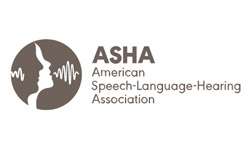 | Everyday Interactions and Activities to Build Preschoolers' Speech and Language Skills What: Activity ideas to build a preschooler's speech and language skills at home while completing everyday activities. Who: This requires parent support. |
Traumatic Brain Injury
For individuals who have sustained a head injury and may have memory deficits as a result.
| Memory Activity | What: Using a deck of cards, have the caregiver slowly flip them over one at a time. After a card has been placed face down, have the individual state what it was (i.e. either stating only the suit or the suit and number to increase the difficulty). You can also use 3-5 cards (i.e. a standard deck of cards or object cards from a game such as Heads Up), have the client look at all 3 for a limited amount of time. Then, turn the cards over and carefully shuffle them around. Then, have the individual pick one at a time while stating what they remember it to be. You can each take turns to make it more of a game. Who: This will require caregiver instruction and support. |
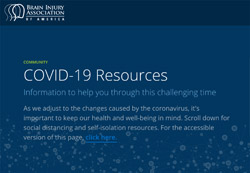 | Brain Injury Association of America What: The link above directs you to the Brain Injury Association of America. This page offers community COVID-19 resources including general information about brain injury and COVID-19, a video series to support staying connected while social distancing, and steps you can follow to gather more information through their social media. Who: Caregiver instruction and support required. |
 | The University of Alabama at Birmingham - Traumatic Brain Injury Model System What: These at-home tasks center around attention, academics, fine motor, language, memory, problem solving, speed of processing, and visual spatial skills. Directions and a list of materials are included for each task. Who: This will require caregiver instruction and support. |
 | What: This link directs you to BrainLine. This page provides information about the importance of a community and support groups after TBI. A link to a Facebook group is also provided for those who are interested in joining a support group. Who: Individuals who have suffered from a traumatic brain injury and/or their caregivers. |
 | What: At the BrainLine website, a list of tools that may be of benefit to those who have suffered from a TBI and how they can be used in daily life are provided. Who: This will require caregiver instruction and support. |
Augmentative & Alternative Communication (AAC)
For individuals who use a high-tech or low-tech device to assist their communication.
| International Society of Augmentative and Alternative Communication | What: This website offers AAC information and supports for clients and families. Follow the link on the left for more information. Who: Parent/caregiver support is required. |
 | AAC Communication Boards for Intensive Care Units What: This webpage provides downloadable PDFs of communication boards intended for use in the acute care setting with patients who are intubated or otherwise unable to effectively communicate with their care providers. They were developed through a collaborative project between the University of Nebraska-Lincoln and Bryan Health, with input from professionals in occupational therapy, speech therapy and nursing. Two versions are available – simplified and complex – to best meet the needs of the patient. Page topics include activities of daily living, basic needs, food, leisure, pain management, people and questions. A navigation page is included for patient-initiated communication. There is also a message board and alphabet board for more novel communication opportunities. Who: Clinicians working with communicatively vulnerable patients in the ICU. Contributed by: Lauryl McClintick and Dr. Kristy Weissling |
 | What: This PDF provides a letter board in either alphabetical or QWERTY format to support individuals who may need assistance communicating their needs, wants, ideas. This PDF also includes instructions for how a communication partner can help implement the low-tech letter board or use partner-assisted scanning (see PDF for step-by-step instructions). For more resources with yes/no boards, pain scales, etc., please click this link. Who: This will require caregiver/communication partner support. |
 | What: Multiple Tobii Dynavox resources on the coronavirus are included at the link above. Specifically, the resources can be used to teach vocabulary about the coronavirus, offer simplified steps for washing your hands, and provide a daily and weekly learning schedule for students at home (e.g. first, next, last format). Additional resources include communication boards for individuals within a hospital setting (i.e. available to download in a variety of languages on the linked Tobii Dynavox website). Who: Resource use will require caregiver support and instruction. |
 | What: This link directs you to Saltillo’s YouTube channel. They feature a monthly story time video, as well as provided a PDF of activities that correlate to the book (see this link). Continue to follow along each month to watch Satillo’s story time activities. Each video features a group of specific core words, as well as additional activities that parents or caregivers can implement while their child follows along. Who: Parent and caregiver instruction/support required. |
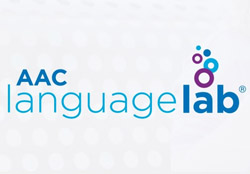 | What: This link directs you to the AAC Language Lab’s YouTube channel. The YouTube channel features tutorials, trainings, activities, success stories, etc. all related to AAC. Who: Parent and caregiver instruction/support required. |
 | What: University of Kansas doctoral student, Susan Todd, has created a live AAC story time using a Facebook group. Follow the link above and like the Story Time by AACtual Talk group for information on the book and core words that will be modeled every Tuesday. Who: Parent or caregiver instruction/support required. |
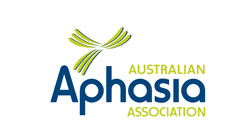 | Australian Aphasia Association What: This link directs you to the Australian Aphasia Association. Here, they have provided a variety of resources for people with aphasia using low-tech AAC. Visit the link to download resources featuring COVID-19 key word signs and an AAC board. Who: Caregiver support required. |
| Philippine Association of Speech Pathologists | What: The Google Drive link to the left directs you to a folder with multiple communication boards for patients who are unable to speak. The resources were provided by the Philippine Association of Speech Pathologists. Examples include: yes/no boards, general needs, pain scales, personal needs, medical needs, wants, medical decision making, as well as an alphabet board. Who: Caregiver or clinician use. |
 | Assistive Technology Industry Association What: The link above directs you to the Assistive Technology Industry Association: COVID-19 Resources. This organization has a list of free webinars and online resources to further your learning. Upcoming webinars feature tools for remote learning, strategies for remote learning students with disabilities, communication supports/resources (presented by Tobii Dynavox), creative ways to support AAC online and at home, etc. Moreover, a list of COVID-19 resources are available. Who: Clinician/caregiver education & use. |
 | Rehabilitation Engineering Research Center What: The link above directs you to the Rehabilitation Engineering Research Center website. They have provided a post titled "Communication supports for individuals with complex communication needs during the COVID-19 pandemic." Topics discussed include preparing in advance, supporting their understanding of COVID-19, supporting expressive communication, etc. Who: For clinicians, healthcare providers, caregivers and clients. |
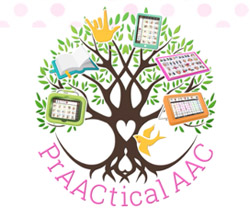 | What: The PrAACtical AAC website above features an AAC video of the week over a variety of topics (e.g., telepractice, strategies for remote learning environments, etc.). Who: Clinician use and education. |
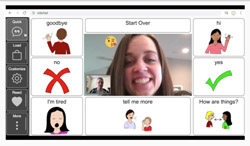 | Video-Conferencing Application What: This resource provides limited trial access for individuals who cannot speak, but want to connect with others over video-conferencing platforms. It has also been developed to support individuals in hospital and medical groups throughout the pandemic. Who: Clinician and caregiver support required. |
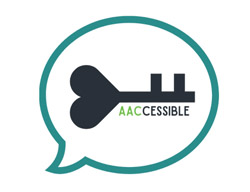 | What: This link directs you to the AACcessible website. This page provides resource3s, supports, trainings (live and on-demand), and virtual events that share information on a wide array of subjects pertaining to AAC. This website also helps families and professionals find AAC services in their area. Who: For clinicians, families, and AAC users. |
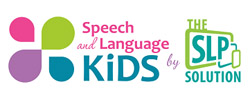 | Parents' and Teachers' Guide to Getting Started with AAC What: This website provides a list of suggestions for parents and teachers about how they can help a child use AAC in daily interactions. This article is tailored toward high-tech AAC; however, it can apply to those who use low-tech AAC as well. Who: This will require caregiver/communication partner support. |
Aphasia
For individuals who have a reduced accessibility to both understand and express language.
 | What: A complete listing where people can go to find out which groups are currently meeting online. Who: Caregiver support may be required. Reliable internet access, a camera and a microphone are needed for Zoom. |
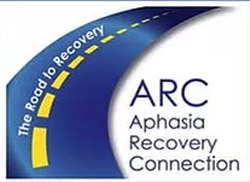 | What: The various links on this website can guide you to support groups, a video-conferencing program where you can talk with other people with aphasia, or download communication boards. Who: People with aphasia and their family/friends. |
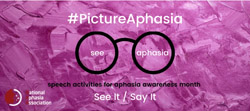 | Aphasia Awareness Month: See It / Say It What: June is Aphasia Awareness Month! This link directs you to the National Aphasia Association website where weekly activities for the month of June will be posted. The activities use images or videos to help strengthen communication skills. Who: People with aphasia and their family/friends. |
 | What: This is a free program that individuals with aphasia and their family members can attend. The daily sessions are led by either an SLP, music therapist or aphasia expert. These virtual meetings provide individuals the opportunity to discuss specific topics each day (see the calendar in the link above), engage with other people, and work on communication skills. Who: Caregiver support may be required. Reliable internet access, a camera and a microphone are needed for Zoom. |
 | What: This pdf offers an aphasia-friendly handout for clients to understand what COVID-19 is, symptoms associated, and how to respond. Who: Caregiver instruction and support is required. Contributed by: Natalia Nolting |
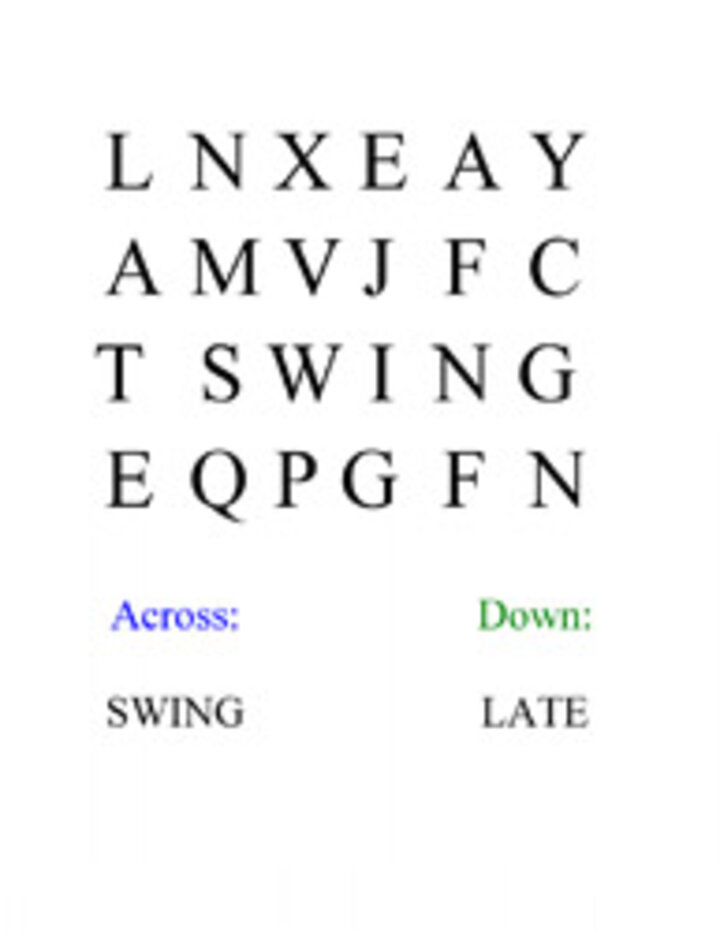 | Aphasia Word Search & Picture/Word Matching Activities What: These resources can each be implemented for individuals with Aphasia. Word searches and picture-word matching activities provide a great way to continue reinforcing word use at home. They are beneficial in keeping the mind active and supporting continued interaction with letters. There are multiple word search PDFs attached (with or without across/down visual supports), as well as various picture-to-picture or picture-to-word matching activities available to print. Who: Caregiver instruction and support is required. Contributed by: Joanna Mackley and Veronica Musser |
What: The links to the left each offer a variety of additional family and client resources on COVID-19. Who: Caregiver instruction and support required. | |
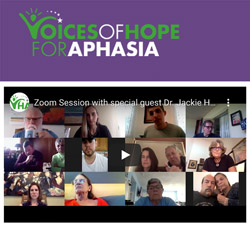 | What: The above link directs you to the “Voices of Hope for Aphasia” website. Since the onset of COVID-19 and taking precautions, this group is now using online group Zoom and Facebook sessions to help individuals with aphasia stay connected. Visit the website to view their weekly online schedule and check out the video of a recently conducted Zoom session with Dr. Jackie Hinckley. Who: Caregiver support required. |
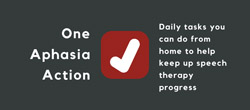 | What: This resource directs you to the National Aphasia Association. Here, One Aphasia Action has outlined a set of everyday tasks you can do at home while the clinic is closed to help support your progress from home. Who: Caregiver support required. |
 | What: This link directs you to the Australian Aphasia Association. Here, they have provided a variety of resources for people with aphasia and their caregivers. Visit the link to download resources including: posters (e.g., hand washing, symptoms, etc.), tips for coping with the coronavirus anxiety, as well as social distancing resources. Who: Caregiver use and/or support required. |
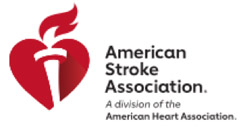 | What: The link above directs you to the American Stroke Association webpage. There is a help and support page which may be useful for caregiver support. Who: Caregiver education and support. |
 | University of Oklahoma Aphasia Support and Communication Group What: The Aphasia Support and Communication Group is a virtual support group for people with aphasia and their supporters. The purpose of this group is to have individuals engage in interactions that encourage motivation and socialization while also providing additional information. Groups meet the first Friday of each month at noon AND the third Thursday of each month at 6 p.m. Use the PDF at the link above to access the Zoom link and password. Who: For people with aphasia and supporters. |
ETSU Communication Support Group What: The ETSU Communication Support Group meets the third Wednesday of each month from 3:30-5:30 p.m. Please contact Courtney Andrews for the Zoom link if interested – andrewscm@etsu.edu or 423-439-4712. Who: Individuals with a communication disorder resulting from stroke/TBI/acquired or progressive neurological conditions and their family/caregiver. | |
 | What: The PDF link above provides a snapshot of information about the aphasia community and their experiences. The purpose of these snapshots is to see if other people with aphasia share similar opinions and experiences. This snapshot in particular covers the opinions of people with aphasia regarding the importance of community connections. Who: For people with aphasia and anyone wanting to learn more about their experience. |
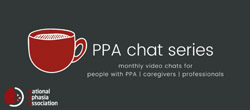 | Primary Progressive Aphasia (PPA) Chat Series What: This link directs you to the National Aphasia Association website. On their website, you can sign up to join the mailing list for the Primary Progressive Aphasia Chat Series. Once on the list, you will receive an email with the Zoom link for the chats. There are two chats per month, each for a different stage of the Primary Progressive Aphasia experience. Pick the chat that fits your needs best, or you can choose to join both chats, all are welcomed. Topics of conversation will change for each session. Who: People with primary progressive aphasia, caregivers, and professionals. |
Autism
For individuals who may have communication or social differences that are seeking treatment related to a diagnosis on the autism spectrum.
 | Autism Speaks Information & Resources for Families What: This page has resources for families who have children with autism. There are behavioral resources, visual supports, social stories, and other articles about autism and COVID-19. Who: Individuals with autism. Parent and caregiver instruction/support required. |
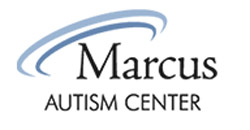 | Marcus Autism Center – Establishing Routines at Home What: This page provides step-by-step direction about how to promote routines at home, and their importance for those with autism. Who: Individuals with autism. Parent and caregiver instruction/support required. |
 | What: This website provides stories to explain COVID-19 to individuals with autism, hand washing visuals, tips for caregivers, and articles for individuals with autism who are struggling to cope with COVID-19. Who: Individuals with autism. Parent and caregiver instruction/support required. |
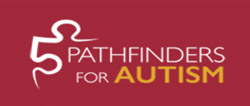 | Pathfinders for Autism What: The website above directs you to the Pathfinders for Autism website. This COVID-19 resource features coronavirus information, at-home activities, educational websites, social stories, and offers a variety of virtual field trips. Who: Parent instruction and support required. |
 | What: The website above directs individuals to social story resources over topics such as: masks, hand sanitizer, doing school work at home, etc. Each of these were created by speech-language pathology students under supervision by Michelle O'Donoghue at the University of Limerick. The social stories are available for download, and can be edited to offer a more individualized approach. Who: Parent and caregiver instruction/support required. |
Stuttering/Fluency Disorders
For individuals and parents of children who stutter.
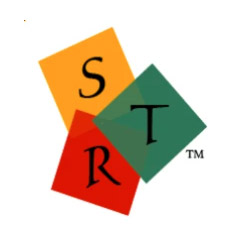 | What: This link directs you to the Practical Thoughts Blog, which features a variety of videos made for parents of children who stutter. These short videos provide communication strategies, home therapy tips, and extra resources such as fact sheets and handouts. Who: Parent instruction and support required. |
 | What: This link directs you to The Stuttering Foundation, which lists seven key communication tips for talking to a child who stutters. Who: Parent instruction and support required. |
 | What: This link directs you to the website, Friends: The National Association of Young People Who Stutter. This website focuses on the emotional impact of stuttering and how it can impact both the individual and the family. The page includes articles, videos, and handouts to provide parents and individuals who stutter with support. Who: Parent instruction and support required. |
 | What: The link above directs you to a PDF handout for families who want to learn more about developmental stuttering. It briefly explains the definition of developmental stuttering, key statistics, risk factors, and emotional components of stuttering. Who: Families of preschool children who stutter. Contributed by: Marisa Potter |
Dementia
For individuals who may experience memory deficits attributed to a diagnosis related to dementia.
Medicare Guide for Nursing Homes What: This link directs you to the Medicare Plans Online Resource Center. Here you will find helpful information about Medicare and answers to frequently asked questions about nursing homes and assisted living. Helpful resource with easy-to-understand information. Who: Caregiver instructions and support. | |
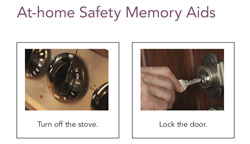 | What: The attached PDFs are provided from the Health Professions Press. Resources for individuals with dementia include a pain assessment scale, memory aids for home safety, personal hygiene checklists (using simplified steps), and a step by step bathroom/morning schedule. Each of these have been modified to support individuals with potential memory/cognitive impairments. These could each be printed off and placed around an individual’s home to help them when they become confused or need guidance (e.g. steps to getting ready). Who: Caregiver instructions and support will be required for safe and appropriate use. |
 | What: This link directs you to the Alzheimer’s Association website. The website provides tips for dementia caregivers within long-term care settings. They also have provided a checklist PDF from the CDC for older adults related to how best to protect themselves, as well as ways to prepare for the virus. Who: Caregiver and clinician instruction/support required. |
 | What: This link directs you to the Dementia Alliance of North Carolina website, which features a variety of family resources throughout COVID-19. Resources include videos, webinars, as well as virtual support groups to participate in. Who: Caregiver instruction and support required. |
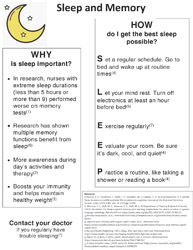 | What: The attached PDF is a valuable resource that discusses evidence-based benefits of sleep in relation to memory. Download the PDF above to read about why sleep is important and steps you can implement to get better sleep. Who: Caregiver instruction and support required. Contributed by: Meredith Konkol |
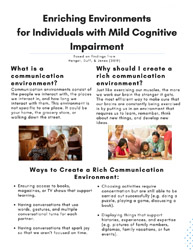 | What: The attached PDF provides valuable information on what a communication environment is, why it is important, as well as steps you can take to enrich your environments for individuals with mild cognitive impairments. Who: Caregiver instruction and support required. Contributed by: Haley Gracey |
 | What: The above resource discusses what your rights are in health care settings, how to protect your rights in a hospital, and includes legal references. Moreover, there is a collection of Communication Phrases that can be downloaded. Who: Patients with dementia and their caregivers. |
Family Activities for the Home
For families who are looking for enjoyable and educational activities while at home.
 | What: This website provides thousands of free online jigsaw puzzles for people of all skill levels. Who: Puzzles are available in easy, medium and hard levels. Parent/caregiver support may be helpful. |
 | What: This website provides recipes for families, age appropriate ideas and tips for cooking with kids, as well as activities to implement at home to support physical activity. Who: These can be modified for a variety of ages and will be promoted by parent/adult supervision. |
 | Also, follow @SheldonMuseum on Facebook, Twitter, Instagram and YouTube for more information and activities. One in particular will feature a weekly Instagram post of a staff member's favorite work of art and an open invitation for people to "Ask Sheldon" anything. What: These links direct you to the Sheldon Museum of Art where your children, students, or family members can appreciate an assortment of art pieces. While viewing these, you can support a variety of skills such as vocabulary development, pronoun use, or sentence expansion by using the art to prompt specific targets. For example, asking the child to create a sentence about the art using their vocabulary word/s, asking prompts that encourage pronoun use (e.g. "Who is holding the dog? She is holding the dog.") or encouraging the student to write a creative sentence about what they believe is occurring in the art piece (i.e. using a complete sentence format with a subject, verb and object) would each be educational. –For individuals who may have aphasia or a diagnosis that contributes to a limited output of speech, please reference this PDF. While viewing the art of the week or browsing the exhibitions, the individual may express their thoughts by pointing to indicate if they liked the art, disliked the art, or would like to ask a follow-up question (i.e. prewritten on the PDF). Who: Parent or caregiver support will be required. |
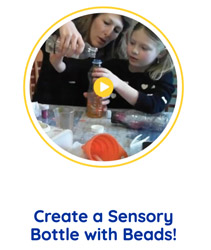 | What: The link above directs you to the Fun and Function website. Various videos have been created to allow you and your child/ren the opportunity to learn how to create your own snow globes, anti-anger bubble jars, or sensory bottles from your home. Who: Parent or caregiver support required. |
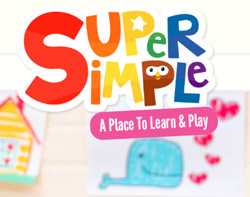 | Super Simple: A Place to Learn & Play What: The link above directs you to "Caitie’s Classroom." This website features 22-minute educational videos that each have a specific theme (e.g., “All About Art”) and incorporates singing, dancing, learning, playing, creating, etc. There are also free printables to go along with the various shows. Who: Caregiver/parent instruction and support required. |
 | What: The link above directs you to the Eat Right website. Information is provided for both adults and kids related to nutrition and health during the COVID-19 pandemic. Multiple games and activities (i.e., crosswords, word finds, mazes, etc.) are available for kids to use, as well as cooking tip sheets for adults. Who: Parent or caregiver support required. |
 | What: Nebraska Extension is encouraging kids to be active during the COVID-19 pandemic by hosting a virtual Marathon Kids club. Follow the link above for more information on how to join and track your miles using the printable running logs. They also offer ideas for warm-up activities, cool-down activities, and running games. Encourage your children and family to have fun and be active! Who: Parent or caregiver support required. |
 | What: The link above directs you to Kids Yoga Stories. This is a fun platform to encourage children to be active and use their imagination. Follow the link for access to 58 yoga poses for kids. Who: Family or caregiver support required. |
Clinician Resources
For speech-language pathologists to reference during the COVID-19 pandemic.
 | Green Screen Teletherapy for Zoom What: This resource outlines why Zoom/green screens are helpful, tips and tricks for teletherapy, what is needed to be successful in teletherapy, and how to use Zoom for teletherapy. Who: Clinician use. Contributed by: Brynley Klein |
 | Barking, Havering and Redbridge University Hospital Twitter What: The above link directs you to the Twitter account for Barking, Havering and Redbridge University Hospital. Team members at the hospital have designed a template for staff to wear a “Hello, my name is…” sticker while working in environments where personal protective equipment (PPE) is required to prevent the spread of COVID-19. These stickers are purposeful in helping patients and families be able to identify who is working with them, as PPE equipment may make identifying individuals more difficult. You can learn more about the hospital and see pictures of team members using the stickers by checking out their Twitter page. Follow the Google Drive link for access to the template that hospital members have shared. Who: These can be used or modified for a variety of healthcare workers such as: speech-language therapists, physical therapists, doctors, nurses, radiologists, etc. |
 | American Speech-Language-Hearing Association Coronavirus Updates American Speech-Language-Hearing Association Telepractice Resources What: During the COVID-19 pandemic, clinicians have the opportunity to serve clients through telepractice. Please follow the links above for resources from the American Speech-Language-Hearing Association (ASHA). Such information includes state laws, insurance information, as well as resources to assist you in providing services. Who: For clinicians seeking more information on the service delivery options related to telepractice, as well as educational webinars related to treating and evaluating clients. |
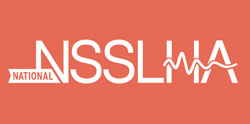 | National Student Speech-Language-Hearing Association What: Follow the link above for clinician and graduate student resources related to graduate programs, telepractice resources, etc. Who: For supervisors and students to reference. |
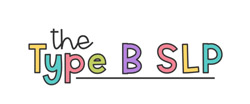 | What: This resource was provided by the Type B SLP for clinical use throughout the COVID-19 pandemic. Follow the link above to access a list of 50 free resources for a variety of clients. Who: Clinician use. |
 | Australian Aphasia Association What: This link directs you to the Australian Aphasia Association. Here, they have provided a variety of resources for people with aphasia and caregivers. Visit the link to download a resource featuring a checklist planning tool for discharging a patient from the hospital. Who: Clinician use. |
 | What: Aphasia Access features a wide variety of resources available for clinicians, professionals, and aphasia group leaders. Who: Clinician and professional use. |
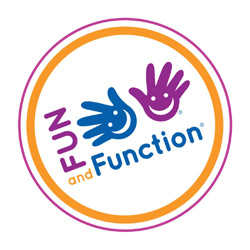 | What: The link above directs you to the Fun & Function website. Here, they have compiled a variety of upcoming Zoom webinars. Topics include: setting boundaries, dyslexia, etc. Who: Clinician educational use. |
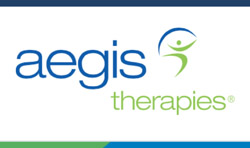 | What: The resource above directs you to Aegis Therapies website. Aegis Therapies and HealthPro Heritage collaborated to host a free webinar for professionals who are working with patients during the COVID-19 pandemic. They have recorded a webinar from April 14 and discuss what information interdisciplinary members need to know related to best practice and clinical decision making. Who: Physical therapist, occupational therapist, speech-language pathologist education. |
 | What: The link above directs individuals to Tabitha’s blog page. They are offering online community support groups to individuals experiencing loss and grief following a loved one passing away. These are free and open to share with individuals throughout the community. Who: Caregiver/clinician instruction and support required. |
 | What: For individuals looking to further their knowledge aside from receiving continuing education units, the StutterTalk podcast provides reliable information related to a variety of topics to expand clinical knowledge and promote active learning. Who: Clinician education related to stuttering. |
 | What: The Stuttering Foundation Podcast provides reliable information related to a variety of topics to expand clinical knowledge and promote active learning. Who: Clinician education related to stuttering. |
 | What: This is a valuable resource that SLPs can attend through a virtual Zoom application. At the conference, SLPs can look forward to gaining insight into stuttering, helpful strategies, as well as becoming a more confident clinician. Who: Clinician education related to stuttering. |
 | What: The resource below features multiple webinars available for playback, as well as upcoming sessions surrounding a range of topics around behavior, stress, learning environments, managing self-injurious behaviors, etc. Who: Clinician education. |
Telepractice with AAC Resources What: These links are provided by the Tennessee Talks project. Multiple tele-AAC resources are provided for speech-language pathologists to support their clients during the pandemic within this Google doc link. Who: Clinician education and use. | |
Handwriting What: The resource above directs you to Child Development & Rehabilitation. A variety of resources are available for handwriting skills for both lowercase and uppercase printing. Who: Clinician use. | |
 | What: The link above directs you to a podcast series titled, "Speech Uncensored." They have a variety of episodes covering your choice of populations and topics, as well as a new series on telepractice. Who: Clinician use. |
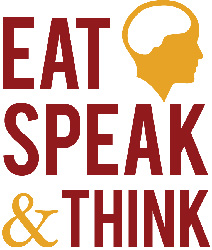 | What: The website above directs you to a variety of resources for both clinicians and patients to support them during the COVID-19 pandemic. Resource topics feature AAC, aphasia, therapy materials, self-care and more. Who: Clinician and patient use. |
 | What: The website above is helpful in identifying three ways to mirror apps during telehealth sessions using an Android or iPad. Visit the link for a free four-page handout with further instructions and a video. Who: Clinician use. |
| Dysphagia Management Webinar | What: The link to the left directs you to a recorded webinar on the SLP's role in dysphagia management during the pandemic. This is hosted by ASHA Special Interest Group #13. Who: Clinician education and use. |
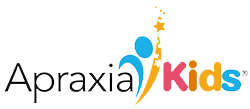 | What: The website above, Apraxia Kids, is helpful in providing an overview of teletherapy services. It provides links to ASHA to determine your state’s licensure law. It also offers tips for both families and clinicians. Clinician resources are listed as well. Who: Clinician and family resources. |
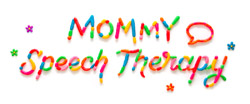 | What: The website above, Mommy Speech Therapy, has provided free therapy worksheets for articulation, story structure, and more. Who: Clinicians. |
Other COVID-19 Resources
For family members and caregivers to reference during the COVID-19 pandemic, featuring information on the virus as well as links to other COVID-19 resource websites.
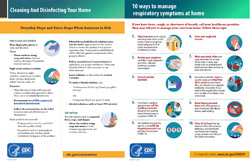 | What: These resources from the Center for Disease Control and Prevention provide step-by-step guides to managing respiratory symptoms at home, as well as tips for cleaning/protecting your home. Who: For any individual looking for COVID-19 precaution information. |
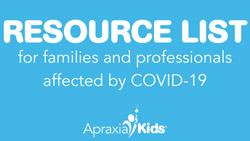 | What: The link above directs you the Apraxia Kids website. This organization has compiled a list of resources for families and professionals affected by COVID-19. Professionals can review therapy resources, COVID-19 announcements, telepractice information, as well as browse various webinars available to watch. Families can continue to scroll down for resources related to talking about the virus with your child, browse at-home speech therapy resources, webinars for families, and more. Who: Family and professional use. |
 | Early Childhood Special Education What: This link features a compiled list of resources for parents and educators. Resources include topics related to language/communication, instruction, social emotional and behavior, self-regulation, supporting challenging behaviors, etc. Who: Caregiver, parent, and educator use. |
 | What: The link above directs parents to the Region 13 Coaches page. Their organization has compiled a list of choice boards and sample schedules for various grade levels (i.e., pre-k through high school). Who: Parental education and use. |
 | What: The link above directs you to a Google Drive folder put together by the New Philadelphia City Schools. Their PDF resources provide a variety of target speech and language skills at home, games using the expanding expressions tool PDF, daily/weekly student planners, as well as literacy activities. Who: Parent instruction and support required. |
 | Rhode Island Department of Education What: The link above directs you to the Rhode Island Department of Education (RIDE) website where they feature a variety of COVID-19 supports directed to teachers, paraprofessionals, parents, etc. Who: Education and support for parents, clinicians, teachers, etc. |